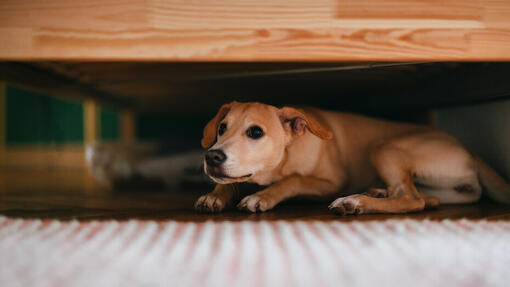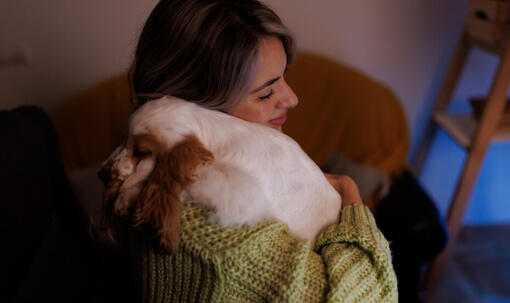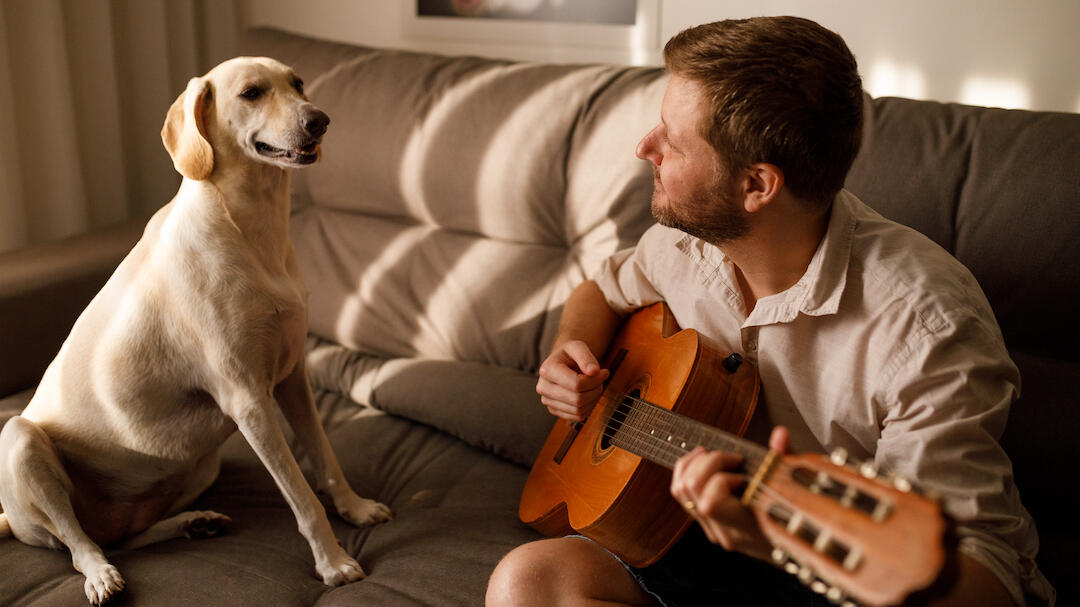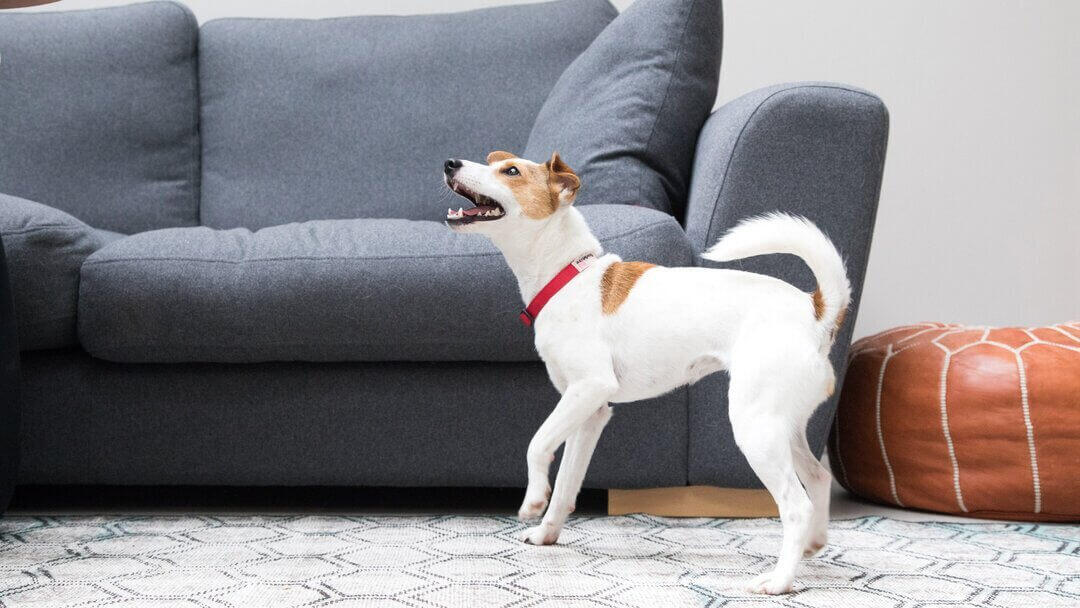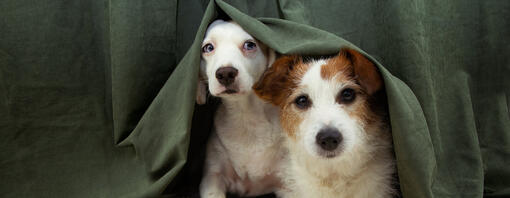
As a dog owner, you may have noticed that thunderstorms aren’t really your furry friend’s cup of tea. They certainly aren’t alone, in fact, many dogs experience noise phobia – an intense fear or anxiety triggered by loud or unexpected sounds – and in the case of storms, this trigger can be thunder but, in some cases, it can also be the noise of rain or wind.
If your dog is scared of thunder or is worried about storms, there are steps you can take to help them feel more calm and secure during thunderstorms.
From creating a cosy space to trying to keep them entertained and distracted, we put together a few ways in which you can be there for your dog during storm phobia episodes. Read on to learn why storms are unsettling for your furry friend and how to help them overcome these challenging situations.
Why is my dog scared of thunder?
Storm phobia or thunderstorm phobia is a variation of noise phobia and is a common issue for dogs. It is characterised by an extreme fear (phobia) of any of the noises associated with storms – and often their predictors.
It’s common for many dogs who develop a fear of thunder, to also react negatively to other meteorological changes that happen during storms such as lightning, strong winds, or rain. They may also be able to detect the pressure changes that heralds a storm’s approach and so start showing anxiety long before we even realise the cause.
When it comes to loud sounds such as thunder, prevention is far better than cure when it comes to preventing noise phobias. We know that dogs can’t avoid hearing thunder in their lifetime – so we should be preparing them for it right from puppyhood.
A good breeder will start introducing noises to their puppies such as thunder and fireworks from very early on in their lives. This can be done by playing these sounds (which are easily found on the internet) at times when they are doing enjoyable things such as playing or eating. They can be started off very quietly so the puppies can hardly hear them, and they can gradually be increased in volume but always making sure there is no reaction at all from the pups. This is then something you can continue when your new arrival comes home with you.
Causes of noise phobia
It is part of an animal’s survival strategy to be afraid of things that they haven’t experienced before (which is why introducing strange and unexpected noises in early puppyhood is so important) – especially if it produces a strong negative response such as fear. While we know what a storm is, if a dog hasn’t experienced anything like that before, it’s easy to see how they can think of that as being potentially dangerous. Driving rain, howling wind, flashes of light from the sky, all rounded off with ear-splitting crashes of thunder… That definitely falls into the category of scary.
Dogs who have had a great upbringing as puppies with lots of socialisation and habituation during those crucial weeks when they can learn what is just a part of life and nothing to worry about, and who have been introduced to thunder and storm sounds during this time, are more likely to be able to take the real thing in their stride. Also, some breeds are a lot more laid back and have good bounce-back skills – while others are much more reactive or worried about novelty.
If the first time a dog hears thunder is when they are surrounded by a storm, it’s not surprising they find it frightening.
Any experience that produces a strong negative emotion, such as fear, will not habituate instead it will sensitise. In other words, a dog will not get used to it, instead they will get more fearful with each exposure – and so a fear becomes a phobia.
The symptoms of storm fears and phobias in dogs
Whenever dogs are experiencing storm fears or phobias, they will display some or all of the following symptoms:
- Pacing
- Trembling
- Panting
- Drooling
- Hiding (or increased clinginess)
- Whining
- Incontinence
- Loss of appetite
- Aggression (especially if you try to move them from a perceived place of safety)
In some cases, your dog might even try to escape the home and run away. Since it’s a highly distressing condition for your dog (and you), it’s best to seek professional help, especially if you have already followed the instructions below:
How to calm a dog scared of thunder?
Preparation before a storm
Making sure your dog feels safe during a thunderstorm is crucial.
Find a space in a room where your dog is comfortable – and where you will be during a storm – away from windows and doors. If your dog is crate trained and likes being in a crate, you can set that up with comfortable bedding and toys., Completely cover it with a blanket (apart from the access), to make a ‘den’.
Have this set up all the time during ‘storm season’, so they get used to going in and out of it when they want it and feeling safe and secure in there. Make sure it is comfortable with several layers of bedding that already smells of your dog and has a water bowl just outside. If your dog has any favourite toys, put them in there just to surround them with familiarity and comfort.
If however, your dog has a preferred ‘safe space’ (such as under a sofa or bed), make sure that is comfortable too and let them use that. It is up to your dog to decide where they feel safe. It's important that this safe area is always available and accessible to the dog (whether or not there are storms).
If you know storms are forecast, make sure you have given your dog their regular exercise long before it starts – and most importantly that they have had a chance to go to the toilet. Desperately needing to go to the loo but not being able to because of a raging storm outside is going to make things far worse.
If the storm is likely to clash with your dog’s mealtime, consider feeding them a little earlier (as dogs will not eat if frightened, anxious or scared).
During a storm
Close all the curtains so that your dog can’t see the flashes of lightning and to slightly muffle the sound.
Providing background noise is also a good idea. A dog’s hearing is far better than ours and you will never be able to disguise thunder totally – but it will sound far louder in a quiet room. Having the TV on or playing music can help the weather noises sound less dramatic.
Try distractions such as training, enrichment games, scent games to get your dog to think about something else. This will not work for a phobia, but it may distract a dog who is just slightly worried.
Whenever they are scared, dogs will often turn to their owners to see how they are reacting to the situation and to help access the potential danger. In these moments, it’s important to be calm and reassuring. If they see that you’re okay, they are more likely to feel better. No matter how your dog is behaving, stay relaxed and outwardly cheerful and upbeat.
If your dog comes to you for reassurance, make sure you give them what they need. Some dogs will want to be as close to you as possible, cuddle into you, and need physical touch. Others just need to be near you and get comfort from your presence but are too stressed to be touched or stroked. Be guided by them as to what will make them feel better – and never underestimate how much your comfort will help them.
If they choose to hide or go to their den, sit close to them and talk to them so they know you are there. Never try and encourage them – or pull them – out. They will come out in their own time.
Do everything in your power to make them feel safer and protected. In other words, do what you would like to have done to you in a situation where you are very scared. In summary:
- Distract with music, toys and games if you can.
- Let them go to their safe space.
- Give them comfort from your presence and as much physical contact and affection as they want.
- Avoid any punishment (don't shout or get annoyed because they are barking or scratching the door or sofa).
- When everything is over, talk to your vet about possible help for your dog for the next storm.
Since storm phobia is likely to only get worse with time, it’s best to try and act as soon as you notice to signs.
Seeking professional help
It’s important to know that storm phobia in dogs is a serious and distressing behavioural issue. Talk to your vet first and ask to be referred to an accredited behaviourist who can help your work with your dog’s noise phobia – as this can easily become more severe in time – and can lead to a more general anxiety.
This anxiety arises when the dog worries so much about the storms, that they spend all their time worrying about when the next one will happen or start to react to any of the precedents to a storm (such as rain, wind, or changes of atmospheric pressure). This can result in a reduction in quality of life.
Storm phobias in dogs can be heart-breaking to witness but with some time and effort, you can help your furry friend learn how to cope in these distressing situations. Is your dog fearful by nature? Read the Helping a Scared Dog article next to learn what you can do in this situation.



